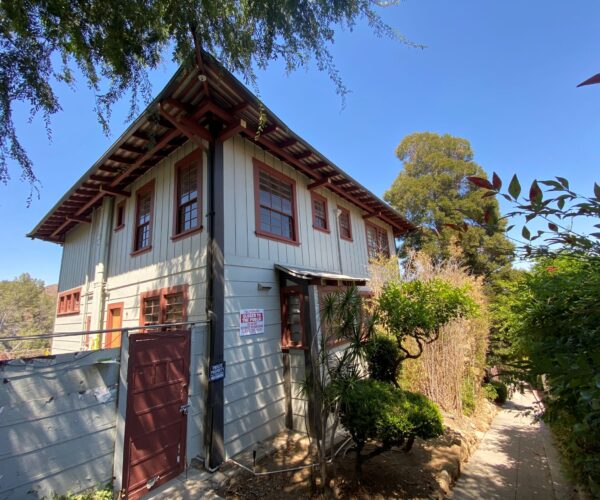
Place
Moore House (Demolished)
A striking example of modernism in a city dominated by Spanish Colonial Revival and Mediterranean Revival homes, the design was nearly rejected by Palos Verdes Estates.
Lost
Despite intense public outcry and advocacy efforts, this highly intact home by Lloyd Wright was demolished in 2012 in a city with no preservation protections.


Place Details
Address
Architect
Year
Style
Decade
Property Type
Community

Photo by Stephen Russo
Overview
Designed by renowned architect Lloyd Wright — the son of Frank Lloyd Wright — and completed in 1959, the highly intact Moore House in Palos Verdes Estates was demolished on April 25, 2012. This was one day after the Palos Verdes Estates City Council denied the Conservancy’s appeal of the decision to allow the home’s demolition.
The house had absolutely no local protection. The City of Palos Verdes Estates has no historic preservation ordinance, and local landmark designation was not available as a preservation tool to help protect the house. Palos Verdes Estates received an F on the Conservancy’s 2003 and 2008 countywide Preservation Report Cards.
About This Place
About This Place
The Moore House was a striking example of modernism in a city dominated by Spanish Colonial Revival and Mediterranean Revival inspired homes.
Wright’s design was nearly rejected by Palos Verdes Estates, whose architectural design guidelines strongly favor a traditional aesthetic.
The unique house featured dramatically angled roof overhangs, walls clad in locally quarried Palos Verdes stone, and expansive windows to take advantage of ocean views.
Wright’s innovative arrangement of interior rooms placed the common areas, including the living room, dining room and kitchen, along with the master bedroom on the upper floor for maximum views of the ocean and coastline. Lloyd Wright (1890-1978), son of internationally renowned architect Frank Lloyd Wright, had a successful career focused in Southern California that spanned over six decades.
Born Franklin Lloyd Wright, Jr., but always known as Lloyd to distinguish him from his father, his career produced such well known works as the Sowden House (1926) in Los Feliz and both the Wayfarer’s Chapel (1951 with later additions) and Bird of Paradise House (1965) in nearby Rancho Palos Verdes. The Moore House, completed in 1959, was designed during a period in which Lloyd Wright’s work was known for flared, flamboyant forms.
Architectural historian David Gebhard has described Lloyd Wright’s postwar residential designs as “agitated, flamboyant and anything but quiet” and “domestic single family equivalents to the sparkling and tinselly world of Wilshire Boulevard.”
These video segments from 1994 explore various parts of the Moore House, which remained highly intact until it was demolished. The videos also include commentary from architect Eric Lloyd Wright (the architect’s son) and an interview with the original owner.
Part 2 – Moore House Interior (Living Areas)
Part 3 – Moore House Exterior (Deck)
Part 4 – Moore House Interior (Living Quarters)
Part 5 – Interview with the late Dr. Louis T. Moore
Many thanks to Louis Moore, Jr. for providing the video, producer Teri Wolf for permission to use it, and Jon Dunham for his crucial editing assistance.
Our Position
The Moore House became threatened with demolition in 2010 when the owners planned to construct a new house on this prime site overlooking the ocean.
The final environmental impact report (EIR) for the demolition and new residential project (formally called the 504 Paseo del Mar Project) was released, and approved, in December 2011. Although the EIR considered the Moore House eligible for listing as a historic resource, it concluded that the house can’t be feasibly renovated to meet the owners’ needs for updated living space.
The EIR didn’t evaluate a single reuse alternative that would maintain the Moore House’s eligibility for listing as a historic resource, despite an outpouring of requests to do so—and the fact that evaluating preservation alternatives is required by law under the California Environmental Quality Act (CEQA).
The Conservancy’s comments on the EIR emphasized our belief that the Moore House can and should be adapted to meet the owners’ needs for increased space, amenities, and energy efficiency. Our comments also refuted the findings presented in both a structural engineering report and an energy performance assessment as inconclusive and failing to provide sufficient evidence that preserving the Moore House is infeasible. The City received hundreds of letters urging preservation of this highly significant, unique home.
Despite such public outcry from the Conservancy and other historic preservation organizations, area residents, design professionals, architectural historians, and individuals across the country and abroad, our pleas fell on deaf ears.
In order to exhaust all administrative avenues, the Conservancy filed an appeal. The appeal went before the Palos Verdes Estates City Council on April 24, 2012.
Despite strong testimony by the Conservancy, the City Council denied our appeal and reaffirmed the certification of the EIR. Demolition began the next day.
The Conservancy’s position is, in a nutshell:
- The Moore House was a rare and significant historic resource, designed by the nationally recognized architect Lloyd Wright (son of Frank Lloyd Wright). It was one of only two structures designed by him in the city of Palos Verdes Estates.
- The EIR failed to identify and evaluate a single reuse alternative that would maintain the Moore House’s eligibility as a historic resource. This is a clear problem, as the EIR must include at least one true preservation alternative.
- The Moore House could have been modified and expanded in a sensitive way that would address preservation concerns as well as several of the owners’ stated project goals. Yet no such alternatives were seriously considered.


